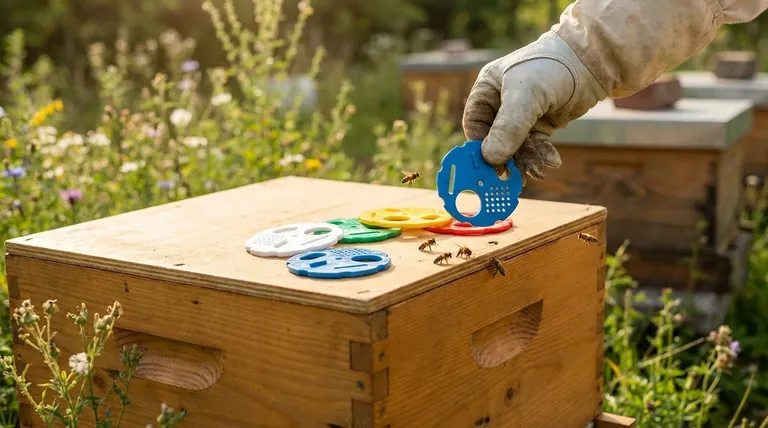In essence, the Flow Entrance Reducer is a multi-function tool designed to manage the hive entrance for colony defense, environmental control, and hive relocation. Its primary purpose is to shrink the size of the hive's main entrance, making it easier for a smaller or developing colony to defend itself against external threats.
The entrance reducer is not a permanent fixture but a strategic tool. Its value comes from knowing when to use it to protect a vulnerable colony and, just as importantly, when to remove it to support a strong one.

The Primary Role: Defending the Colony
A hive's large, open entrance is its greatest vulnerability. An entrance reducer directly addresses this by creating a smaller, more defensible chokepoint.
Guarding Against Robbing
Robbing occurs when bees from a stronger, neighboring colony invade a weaker hive to steal its honey stores. A large entrance makes it impossible for a small population of guard bees to fend off an attack. By shrinking the entrance, you give the defending colony a fighting chance.
Deterring Predators and Pests
A reduced entrance physically blocks or discourages pests like yellow jackets, wasps, and mice from entering the hive. This is especially critical in the autumn when these pests are most aggressive in their search for food.
Supporting a New or Weak Colony
New colonies, whether from a package or a nucleus hive, have small populations. Their top priority is building comb and raising brood, not defense. Using an entrance reducer during this establishment phase allows them to focus their energy on growth rather than guarding a massive opening.
Managing the Hive Environment and Logistics
Beyond defense, the reducer serves several key management functions that help the beekeeper control the hive.
Reducing Drafts and Conserving Heat
In colder climates, a wide-open entrance allows significant heat to escape and cold drafts to enter. A smaller opening helps the colony maintain its crucial internal cluster temperature during winter, reducing their honey consumption and overall stress.
Sealing the Hive for Relocation
The reducer can be flipped over to completely seal the entrance. This function is essential for short-term hive relocation, preventing bees from escaping during transport. It ensures the entire colony arrives at the new location together.
Aiding in Pest Management
When applying certain external mite treatments or other hive management protocols, it can be necessary to briefly contain the bees. The sealed position of the reducer allows you to do this safely and effectively.
Understanding the Trade-offs
Using an entrance reducer at the wrong time can do more harm than good. Acknowledging the trade-offs is key to using it effectively.
The Risk of Overheating
The same feature that blocks cold drafts also restricts airflow. In hot weather, a reduced entrance can hinder the colony's ability to ventilate the hive, leading to overheating and difficulty in curing honey.
Creating "Bee Traffic Jams"
For a strong, populous hive during a heavy nectar flow, a small entrance creates a bottleneck. This "traffic jam" slows down foragers, reduces the colony's efficiency, and can limit the amount of honey they bring in.
How to Apply This to Your Hive
Your decision to use the reducer should be based on colony strength, season, and your immediate goal.
- If you are installing a new colony: Use the reducer on its smallest setting to give the bees a secure, defensible start.
- If your colony is weak or recovering: Reduce the entrance to protect it from robbing and ease its defensive burden.
- If you are heading into winter: Use a medium or small opening to reduce drafts while still allowing for cleansing flights and ventilation.
- If your colony is strong and the weather is warm: Remove the reducer completely to maximize ventilation and foraging traffic.
Properly using the entrance reducer is a direct reflection of your ability to understand and respond to your colony's changing needs.
Summary Table:
| Purpose | Key Function | When to Use |
|---|---|---|
| Colony Defense | Creates a defensible chokepoint against robbing bees, pests, and predators. | For new, weak, or recovering colonies. |
| Environment Control | Reduces drafts in winter to conserve heat and maintain cluster temperature. | During colder months and winter. |
| Hive Relocation | Seals the entrance completely for safe, secure transport of the colony. | When moving the hive to a new location. |
| Trade-off / Risk | Can restrict ventilation and cause foraging bottlenecks if used incorrectly. | Remove for strong colonies in warm weather during a heavy nectar flow. |
Equip your apiary with the right tools for success. Proper hive management starts with quality equipment. HONESTBEE supplies durable, effective beekeeping supplies and equipment—including entrance reducers—to commercial apiaries and beekeeping equipment distributors through our wholesale-focused operations.
Contact HONESTBEE today to discuss your wholesale needs and discover how our products can help you build stronger, more productive colonies.
Visual Guide

Related Products
- Multi-Functional Rotary Hive Entrance Disc for Beekeeping
- Multi-Functional Sliding Hive Entrance for Beekeeping
- HONESTBEE Advanced Ergonomic Stainless Steel Hive Tool for Beekeeping
- HONESTBEE Professional Long Handled Hive Tool with Precision Cutting Blade
- Professional Insulated Winter Hive Wrap for Beekeeping
People Also Ask
- What is the purpose of the steel entrance disc? Master Hive Traffic Control & Security
- How does the outer cover create an upper entrance? Master Hive Ventilation & Congestion Control
- What control does the circular metal beehive entrance disc provide? Master Hive Access & Bee Health
- What are the adjustable functions of the circular metal beehive entrance disc? Master Hive Access Control
- What are the four entrance options provided by the steel entrance disc? Master Hive Traffic & Protection



















